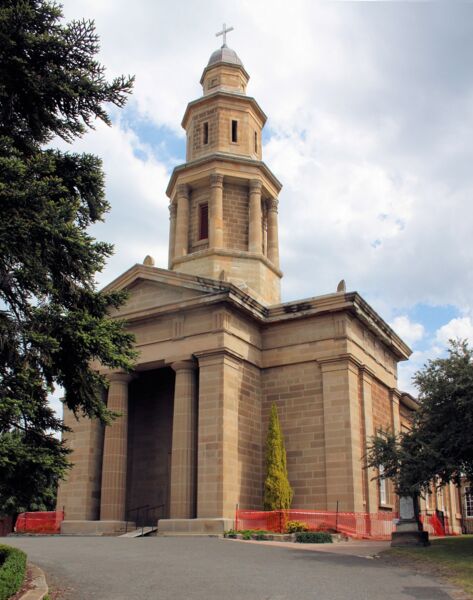Battery Point, TAS - St George's Anglican
Year Built: 1847
Denomination: Anglican
Saint: George
Address: 30 Cromwell Street, Battery Point, Hobart, Tasmania, 7004
Architect: John Lee Archer
Architectural Style: Neo Classical
Last Updated: 19/03/2024
History and Architecture:
Located on the highest point of Battery Point, once known as Kermode's Hill the Church was designed by two of Hobart's earliest and best known architects. The land was in fact purchased from William Kermode for 250.00.
It was designed in the Neo-Classical style by the Government architect, John Lee Archer, designing the body of the building while the tower and porch were designed by convict architect, James Blackburn. The tower was completed in 1847 while the Porch was completed in 1888. The nave was designed by Archer and built by John Wright, cost 1,239.
The tower holds a bell cast at the Swain's Foundry Hobart in 1853 and which weighs in at 405 kilograms.
The building was constructed of sandstone from the Domain quarries, brown rubble stone from Trinity Hill and stringybark from Port Arthur.
The original foundation Stone was laid on 19 October, 1837 by Lieutenant Governor George Arthur 11 days before his tour of duty ended. The foundation stone is not visible now owing to additions to the building. Consecration took place in 1838 by the first, and only, Bishop of Australia, the Rt. Rev. Dr. W. G. Broughton.
The consecration took place in 1838 by the first, and only, Bishop of Australia, the Rt. Rev. Dr. W. G. Broughton while the first Baptism took place on 10 June, 1838, only 15 days after the consecration. The child's name was Charles Graham.
The Tower and Porch was designed by the convict architect James Blackburn, and is very similar to St. Pancras' Church, London,
The Tower was built within ten years of the Nave, but the Porch was not added until 1888. The portion of the Tower where the bell hangs is a copy of the Temple of the Winds in Athens.
Renovations over the years included the tower in 1919, re roofing the nave in 1931 and stone work in 1938.
Clergy:
These names are now in the Database and can be searched individually.
| Years | Name | Annotation | D.o.B | D.o.D |
|---|---|---|---|---|
| 1838 - 1839 | Rev T J. Ewing | |||
| 1840 - 1858 | Rev H P Fry | |||
| 1859 - 1902 | Canon B. Smith | |||
| 1902 - 1913 | Rev Alfred Brain | 1862 | 1944 | |
| 1913 - 1920 | Rev D Baker | |||
| 1920 - 1930 | Rev T. Quigley | |||
| 1931 - 1934 | Rev C. C Short | |||
| 1934 - 1944 | Rev A. A. Bennett | |||
| 1944 - 1952 | Rev L. L Nash | |||
| 1952 - 1971 | Rev A. G. Reynolds | |||
| 1971 - | Rev E. G. Beavan | |||
| 1993 - | Rev W. J. Jolly | |||
| 2009 - | Rector John Langlois | |||
| 2016 - | Rector Victor Shaw |
Organ:
The first organ was built in 1867 by Bishop & Starr, London but was moved to Christ College chapel, Dynnyrne a suburb of Hobart. The present organ was built in 1985 by Australian Pipe Organs incorporating pipework and parts by AbboM & Smith, Vowles and Willis from redundant English organs. It has 2m., 24 sp.st., 7c., el.pn. Gt: 8.8.4.4.2-2/3.2.1-3/5.III. Sw: 8.8.8.8.4.2.III.8.8. Ped: 32.16.16.8.8.4.4.The present organ was built in 1985 and incorporates pipework and parts by Hele and Hunter from redundant English organs.
Source:
1. Church website.
2. St Georges Church a guide to the Church.
3. Organ Historical Trust of Australia with permission.
